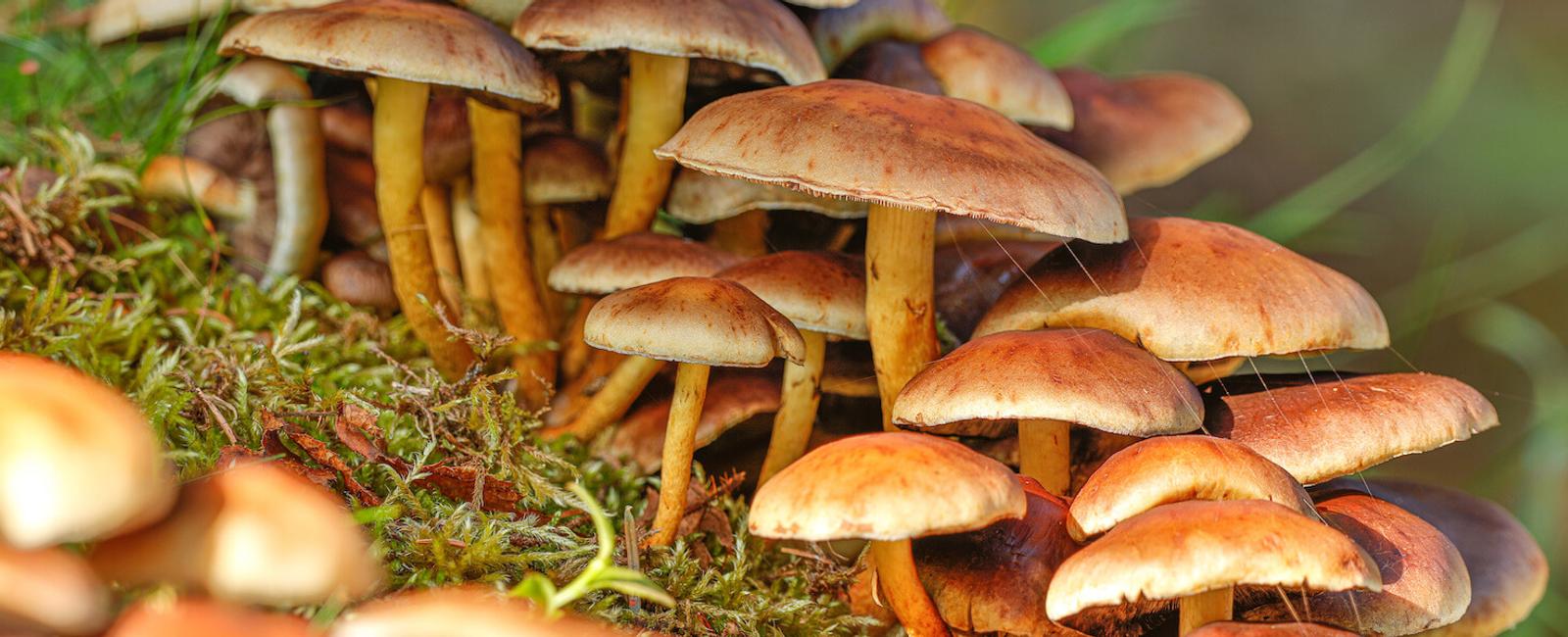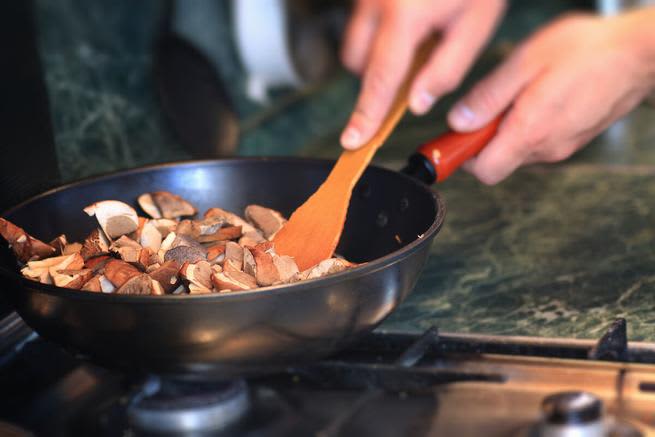

The more people explore medicinal mushrooms, the more popular they become. And with so many varieties of mushrooms, you might have missed learning about Agaricus blazei, a humble little mushroom with many health benefits.
Here, you’ll learn about Agaricus blazei mushrooms, what they look like, where they grow, how these mushrooms can support your body, and much more. Let’s jump in!
What are agaricus blazei mushrooms?
Agaricus blazei (a. blazei), sometimes called Agaricus brasiliensis (a. brasiliensis) or ABM for short, is part of the Basidiomycetes class. It’s an edible mushroom and also a medicinal mushroom, which means it’s recognized as having health-enhancing properties.
It’s also known by several other common names (1):
- Royal Sun Agaricus
- Himematsutake
- Kawariharatake
- Cogemlo de Deus (Mushroom of God)
- Murrill’s Agaricus
- King Agarcius
- Sun mushroom
- Almond Portobello
If it seems like their scientific name is familiar, it’s because it is! Agaricus blazei and Agaricus bisporus (aka white button mushrooms) belong to the same genus (Agaricus). However, they have very different health properties.
What do agaricus blazei look like?
Agaricus blazei mushroom caps can be 7-25 cm across (2.7-9.8 inches) and eventually flatten. Their gills are lighter in color, turning gray and finally chocolate brown as they mature. Expect to see smooth stems with thick flesh that bruise easily when picked.
Their fruiting bodies grow in clusters and singularly; they also smell like almonds, which is even more apparent when cooked (1).
Where do agaricus blazei grow?
These little mushrooms favor humid growing environments and are surprisingly common throughout the southeastern United States. Agaricus blazei is abundant in Brazil, especially around São Paulo in fields and mountainous regions (1).
Historical and traditional use of agaricus blazei mushrooms
This mushroom species was first recognized by an American mycologist, W. A. Murrill, on the Florida lawn of Mr. R. W. Blaze in 1945.
It was later rediscovered in Brazil by Japanese coffee growers and Japanese mycologists are credited with helping bring this medicinal mushroom into the mainstream. While this mushroom was new to the Japanese, Brazilian locals were already familiar with this unique mushroom.
ABM is grown commercially in several areas and it is one of Japan’s most popular medicinal mushrooms. It’s also one of the most expensive (1).
Psst: You may also see this mushroom called Agaricus blazei murrill.
Health benefits of agaricus blazei

Brimming with health benefits, Agaricus blazei are deeply supportive of the body. They’re among the highest protein sources in the mushroom kingdom and contain several nutrients, enzymes, bioactive compounds, amino acids, and antioxidants, including phosphorus, iron, calcium, vitamin B1, B2, niacin, and ergosterol.
And true to its status as a medicinal mushroom, this shroom possesses medicinal properties in spades.
Agaricus blazei produces 1-3 and 1-6D fractions of beta-glucans, polysaccharides that have an effect on the immune system. And these polysaccharides aren’t like usual, run-of-the-mill polysaccharides. Those in Agaricus blazei are unique because they promote an immune response where natural killer cells are cytotoxic to tumor cell lines (why they’re fascinating in immunology and antitumor activity).
Several studies and researchers have discovered that compounds produced by Agaricus blazei have interesting cell activity and induce an immune response where apoptosis occurs only in cancerous cells.
Also of note are the immunomodulatory effects of a secretion released by the mycelium that has antibacterial properties (1).
Traditionally, Agaricus blazei was used to treat a host of diseases in the body, like atherosclerosis and cholesterol (improving lipid profiles), hepatitis, hyperlipidemia, diabetes and glucose management, and cancer. Both in vivo and in vitro studies with Agaricus blazei demonstrate its anticancer and antimutagenic properties. However, its mechanism of action requires further investigation. It also acts as an anti-inflammatory in the body. Aqueous extracts have been shown to protect liver function. (2).
A human clinical study conducted in South Korea found that cancer patients who took the mushroom experienced fewer side effects from chemotherapy, and could be used as one of many adjunct therapies for cancer treatment (3).
Agaricus blazei has an effect on immunomodulating the immune system, with its inhibition of cancer cells and potential impact on cytokine actions. A future clinical trial may explore its action on macrophages and receptor sites in the body.
Ethically wildcrafting agaricus blazei

Before you venture out searching for Agaricus blazei, remember some essential things before ethically wildcrafting your mushrooms. While it may seem that foraging and wildcrafting are similar terms, there are some critical distinctions.
Foraging is often used as a general term for harvesting wild food sources, whether berries, herbs, plants, or mushrooms. On the flip side, ethical wildcrafting refers to gathering local resources for medicinal needs. Its approach is also more nuanced, considering both short- and long-term effects on local ecosystems.
Learning the local area
Learn about the local environment where you’ll be harvesting mushrooms. It may seem counterintuitive, but learning about other mushroom species in the area where you plan on harvesting is well worth the effort. You’ll then know about any endangered or threatened species and become aware of any dangerous lookalikes.
Mushroom identification is essential. Consult a field guide or experienced professional if you need clarification on which mushrooms you’ve gathered.
Depending on where you plan to collect mushrooms, you may also need to look into any permits or special permissions for harvesting.
Mushroom anatomy and proper harvesting
Learning how to properly harvest a mushroom is essential and begins with brushing up on mushroom anatomy. Most of the time, when we think we’re seeing all of a mushroom, we’re only seeing part of it—the fruiting body.
Fruiting bodies are what we see above ground; an equally important part lurking underground is the mycelium. Made up of thread-like filaments called hyphae, a mushroom’s mycelia helps mushrooms intake nutrients from the environment and communicate changes involving weather and if there are nearby predators.
When you know how to properly harvest a mushroom, you can be confident you’re leaving the mycelium intact, allowing the mushroom to reproduce. Bringing the right tools for the job is crucial. There is a debate about whether it’s better to carefully cut a mushroom at the base or gently twist it from the earth. Regardless of your chosen method, do your best to maintain the integrity of the mushroom’s mycelium.
Ecosystem preservation
We’re not the only ones who enjoy feasting on mushrooms. Plenty of critters, large and small, rely on mushrooms for food. As such, we must be mindful of how much we’re gathering and only taking what we need. Otherwise, we risk the health of the local ecosystem. Overharvesting could lead to an imbalance that takes years to repair.
An option worth considering is making a spore print of your Agaricus blazei mushroom. Aside from being helpful in identification purposes and as a piece of natural art, a spore print captures mushroom spores you can use to grow your own.
Even though there’s a little bit of a learning curve (like learning about mushroom spawn and substrate), with practice, growing mushrooms at home can be fun and easy.
Psst: Depending on where you’re located, you may need help finding locally grown Agaricus blazei mushrooms. They aren’t native to the United States, so you’re much more likely to find them commercially grown rather than in the wild.
How can you enjoy agaricus blazei mushrooms?

Agaricus blazei are mushrooms you can enjoy fresh or dried. Known for their distinct almond flavor, you’ll enjoy experimenting with these mushrooms in the kitchen. And since they’re a low carbohydrate food, they’re ideal if you have dietary restrictions.
We recommend keeping it quick and easy with a simple mushroom saute. Melt olive oil and butter in a fry pan and gently cook your mushrooms until they release their liquid and begin to caramelize. Top with fresh thyme and a sprinkle of finishing salt for the perfect side dish or snack on toast.
While you can use dried Agaricus blazei in cooking by rehydrating them, the other way to enjoy this mushroom is as a mushroom extract. These are typically classified as a dietary supplement, and you’ll want to pay attention to where your mushrooms are sourced and how they’re processed.
You may see things like alcohol or water extract on the label of your Agaricus blazei murill extract. There are benefits to both alcohol and water extraction, as they both extract different bioactive compounds from a mushroom.
There’s also the option of finding a dried mushroom powder blend. These are often combined with medicinal mushrooms like turkey tail, maitake, and reishi.
Agaricus blazei: A powerhouse of health benefits
Medicinal mushrooms have earned their place in traditional medicine schools and our modern times for a good reason. Their nutrients and bioactives are profoundly supportive and nourishing to the body, so enjoy them as much as you can, whether that’s part of an evening meal or as an extract in your morning coffee.
Still craving mushrooms? Keep up with us on shroomer. You’ll find all the latest news and breakthroughs on psychedelic and medicinal mushrooms worldwide.
References
Stamets, Paul. Growing Gourmet and Medicinal Mushrooms. Ten Speed Press, 2011. https://fungi.com/collections/books-by-paul-stamets/products/growing-gourmet-and-medicinal-mushrooms
Firenzuoli, Fabio, Luigi Gori, and Guido Lombardo. “The Medicinal Mushroom Agaricus Blazei Murrill: Review of Literature and Pharmaco-Toxicological Problems.” Evidence-Based Complementary and Alternative Medicine 5, no. 1 (January 1, 2008): 3–15. https://doi.org/10.1093/ecam/nem007
DrWeil.com. “Mushrooms to Curb Cancer? - Ask Dr. Weil,” July 7, 2019. https://www.drweil.com/health-wellness/body-mind-spirit/cancer/mushrooms-to-curb-cancer/


